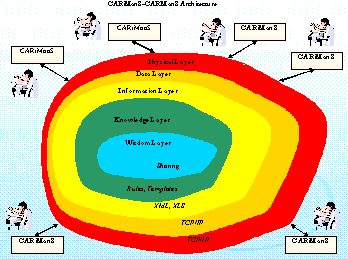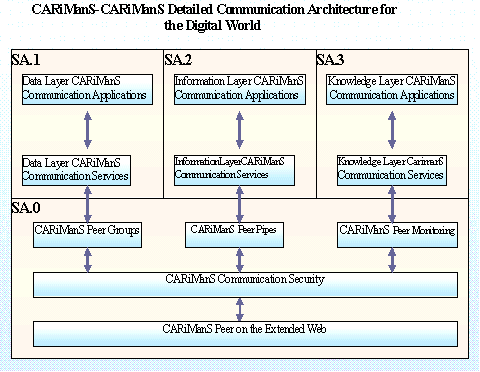|
Network of Excellence |
CARiMan |
The Internet Portal for Computer Aided Risk Management |
SA:
System
Architecture
Responsible:
CST
&
QUB
&
PRO
& LNEC
Assistance:
ICS,
MIS,
PdM
,
Info,
HUn
,TUC,
CEFIN,
UNIMI,
AGH,
HP,
all
partners
The
specific Objectives of this activity are:
o
CaRiManS–CaRiManS Communication network should be web
based, scalable, platform independent and easy to use. Thus, access and
interconnectivity from any EU region will be achieved;
o
Consistency throughout the CaRiManS network,
o
Provide services from a CARiManS peer group prospective
so that failures of individual CaRiManS peers do not affect the service
availability.
o
Clients accessing the databases are free from the
database system being used and data formats as they send queries and receive
responses..
o
Automatic load balancing as every CaRiManS peer service
only responds when it is in position to service the request.
o
Need for minimum service monitoring, as peers provide a
soft state update for availability and inform monitoring CaRiManS peer if they
are overloaded so that new peer services can be started.
o
Provision of digitally signed mobile code for starting
new CaRiManS peer services available in the group context thus ensuring
security.
o
Formation of self-organizing CARiManS peer groups with
adaptive and highly available characteristics.
o
Effective use of peer to peer concepts to solve complex
data management problem with quality of service assurances.
The
detailed CARiManS (Fig. SA-1) is based on the following assumptions:
a.
The data model is preserved as the basic architectural
element and the activities were split as shown at all layers (data layer,
information layer, knowledge layer and wisdom layer), where upper 3 layer
provide the CARiManS backbone.
b.
CARiMan is basically a network (grid) of CARiManS,
geographically distributed and interconnected via available communication
infrastructures.
3. The
basic architecture of CARiManS consists of four layers: data layer, information
layer, knowledge layer and wisdom layer.
4. At
data layer CARiManS has specific plug-ins (all Integrated Activities), each
plug-in will be designed and developed independently as specified in the
Integrating Activities. Actually such a plug-in represents an instantiation of
CaRiManS for different areas.
5. Each
can function independently or plugged into CaRiManS backbone.
6. The
interface task SA has been split to provide the interface at different
abstraction levels. These interfaces have to be defined as XML templates, as
well as communication protocols to be followed by all CaRiManS development
groups.
Many
interconnection technologies will be researched during CaRiManS development
stages. A peer-to-peer interconnection architecture such as JXTA is suggested
for CaRiManS-CaRiManS communications as a possible solution. This solution
implies a set of open protocols that allow any connected device on the network
ranging from cell phones and wireless PDA’s to PC’s and CaRiManS servers to
communicate and collaborate in a P2P manner. The basic idea is to create a
virtual network where any peer can interact with other peers and resources
directly even when some of the peers and resources are behind firewalls and NATs
or are on different network transports.

Fig
SA-1 CaRiManS- CaRiManS Architecture
It
seems that based on this approach we have different levels of communication
between CARiManS. This happens because we might have communication needs at the
data layer such as CARiManS databases replication or mirroring. On the data
layer, all the relevant signal waves recorded by the sensors hosts will be
stored after Analog Signal Conditioning and Conversion. There will be a signal
processing and recognition and evaluation process as a part of the ETM
(Extract-Transform-Migrate) process and the most relevant patterns will be
stored in the CARiManS Database. At the CARiManS Database level, all the data
will be aggregated and all CARiManS will load the most relevant patterns in the
data warehouse for further use. Most probably there will be also some data
consolidation with other sources like and all the data needed to parse the
aggregated data, is stored in the Metadata & Metamodel Repositories. That is
why all the relevant patterns and their metadata should be updated via a
broadcast strategy to all CARiManS in the network, so that different CARiManS
used for risk management in EU area will use the same signal patterns stored in
the grid databases. More than that based on the signal processing a couple of
aggregated figures can be stored and used for certain statistics in the next
level, which is the Knowledge layer.
The Knowledge layer takes profit of all the new technologies regarding
business intelligence and advanced reporting so that comprehensive reports might
be developed.
Moreover
via data mining techniques predictive reports should be able to be developed so
that a certain prediction regarding the risk situations occurrence should be
done. In case of real time monitoring the signal pattern from a sensor will be
compared against a signal pattern in the data warehouse and a notification on
different communication channels will be issued in case of an emergency
intervention request. We might have communication needs at the information layer
so that the aggregated data and corresponding metadata will be updated between
different CARiManS so that all can benefit by a common set of signal patterns
templates. At the Knowledge layer certain statistics might be published so that
all other CARiManS take profit of the knowledge gathered by one of them or a
group. The data mining techniques might be used to develop statistics on risk
situations per geographic areas, and so on. All these, will be handled on wisdom
layer.
Fig
SA-2 presents a detailed architecture of CARiManS – CARiManS communication. It
consists of four components SA.0, SA.1, SA.2, SA.3.
SA.0
encapsulates minimal and essential primitives that are common to SA -P2P. SA.1
through SA.3 includes each of them two basic layers: the CARiManS services and
CARiManS applications. The services layer includes network services that may not
be absolutely necessary for a P2P network to operate, but are common or
desirable in the P2P environment. Examples of network services include searching
and indexing, directory, storage systems, file sharing, distributed file
systems, resource aggregation and renting, protocol translation, authentication,
and PKI (Public Key Infrastructure) services. CARiManS Applications
includes implementation of integrated applications, such as P2P instant
messaging, document and resource sharing, entertainment content management and
delivery, P2P Email systems, distributed auction systems, and many others. The
boundary between services and applications is not rigid. An application to one
customer can be viewed as a service to another customer. The entire system is
designed to be modular, allowing developers to pick and choose a collection of
services and applications that suits their needs.

Fig SA-2 CARiManS Detailed Architecture of SA
We
expect that on the upper three layers a rather small data volume is exchanged
between CARiManS. No real time but data base information is the subject of
communication. We think that Internet has enough speed and bandwidth to
accommodate these data transfers. The real time data transfer takes place on the
lower communication layer SA.0. At this layer we need QoS and a greater
transmission speed. On all layers we intend to build the CARiManS-CARiManS
communication architecture based on TCP/IP. We see no problems for these
protocols to provide any available speed over the Internet or high speed Intranet
infrastructure.
SA.1
and SA2. are mainly accessing remote databases and are searching for specific
data. In fact the main difference between the two layers is data aggregation. A
number of approaches for performing such operation exist ranging from holding a
remote database handle to having sophisticated web services providing a useful
database access layer. It is always desirable to free the applications and users
from low-level details of accessing the databases and provide a suitable level
of fault tolerance and recovery. Redundant and loosely coupled nature of
peer-to-peer networks can be utilized to provide a data access facility with
self-healing characteristic to achieve fault tolerance and availability, load
balancing and adaptation strategies can be used to achieve performance.
Efficient cashing strategies at individual peer can help in optimising the data
access. Services are bound to logical endpoints, which help in migration of the
service implementation from one peer to another without affecting the
availability; it also helps in situation where a service implementation may fail
or temporary become unavailable.
SA.3
is dealing, in addition to remote databases access, also with Intelligent Agents
communication frameworks such as those proposed within FIPA. More precisely, we
aim to employ some standard technologies recommended by FIPA, like JADE, for
developing intelligent agents in order to evaluate their applicability for
CARiManS and, in general, for risk management applications. At this layer we
will also define a set of common ontologies on which the peers must agree in
order to allow knowledge exchange in an open environment, as the grid of
CARiManS is. A set of standard technologies to define ontologies will be
evaluated, including for example RDF and RDF Schema.